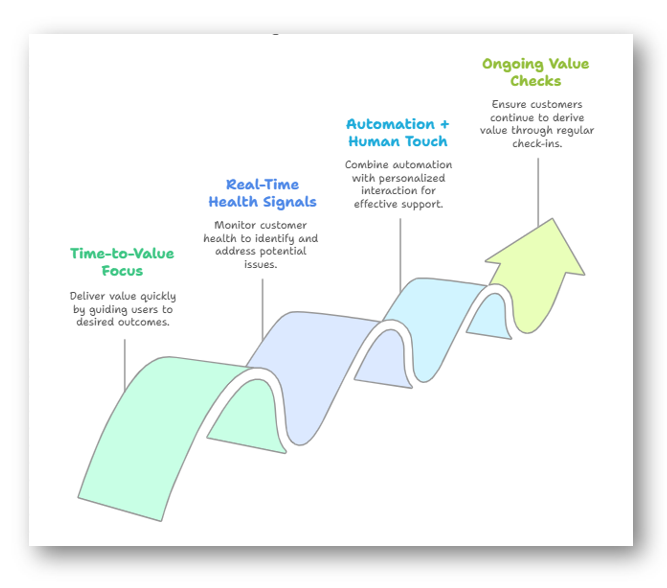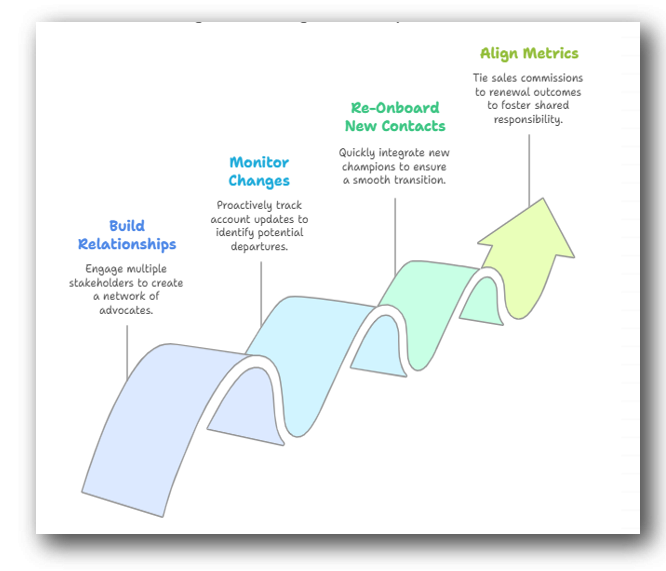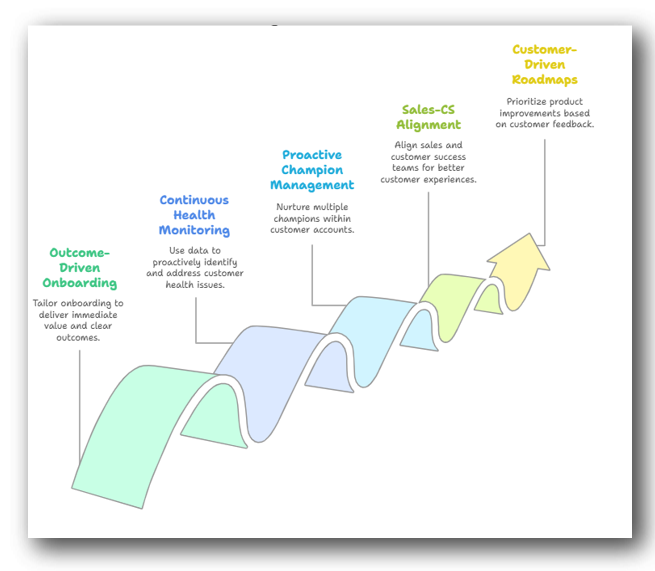Learn proven 2025 strategies to reduce SaaS churn, improve onboarding, protect champions, and retain more customers for long-term growth.
Sonu Goswami SaaS Churn Prevention Tactics for 2025

Discover the two biggest causes of SaaS customer churn in 2025 — failed onboarding and loss of the champion — and learn proven strategies to improve retention.
Customer churn is a critical challenge for SaaS businesses. Even a few percent lost each month can snowball into massive revenue declines. In 2025, two root causes stand out: poor onboarding and losing the internal champion. Both are preventable with the right strategy. By fixing your onboarding process and insuring against champion turnover, you can dramatically boost customer retention and long-term growth.
Why Onboarding Matters for Retention
Poor onboarding is often where SaaS retention is won or lost. If new users don’t achieve their first success (time-to-value) quickly, they mentally check out. Research shows over half of churn is tied to a weak onboarding experience. In other words, most users leave not because of missing features, but because they never saw the promised value. Customers don’t buy software for features — they buy it to solve problems. If they don’t see impact fast, they assume the solution isn’t working and start looking elsewhere.
Onboarding is a make-or-break phase. Slow or confusing kickoffs lead users to “failure-to-launch” churn, where they sign up but never go live. One study found “over 50% of churn can be attributed to a poor customer onboarding experience”
Impact: By contrast, companies that deliver a smooth, outcome-driven onboarding see much higher retention. SaaS firms that map onboarding to real business results (rather than feature lists) help customers reach goals faster. The sooner a user celebrates a win, the less likely they are to churn.
Best Practices: Onboarding That Locks In Customers
Top SaaS teams in 2025 follow a few key principles:

- Time-to-Value (TTV) Focus: Start with the customer’s desired outcome. Design onboarding steps so users reach a meaningful milestone in days or weeks, not months. Personalize guidance around the 2–3 most important “wins” instead of forcing users through all features. When people see value fast, they stay engaged.
- Real-Time Health Signals: Use customer success or CRM tools to watch usage, logins, support tickets, NPS, etc. Automated health scores flag accounts with low adoption or engagement. Spotting trouble early lets you intervene before it’s too late.
- Automation + Human Touch: Combine automated drip campaigns, in-app guides, and checklists with personal outreach. For example, if a user misses a key setup step, trigger an email or in-app prompt. If they still stall, have a Customer Success Manager (CSM) reach out. Balance self-service resources with timely human help for high-value clients.
- Ongoing Value Checks: Don’t assume “no news is good news.” Periodically ask customers if they’re getting the outcomes they expected. Simple surveys or a quick call early on can surface misalignment. If a user isn’t seeing value, course-correct immediately (adjust training, change use case, etc.).
Implementing these practices can turn onboarding from a churn point into a growth engine. For example, Ollie, a brewery ERP platform, rebuilt its onboarding using automated task lists, triggered reminders, and targeted CSM check-ins. As a result, they dramatically cut “failure-to-launch” cases and saw more customers reach their first value milestone. In their words, the new mix of automation and human support “transformed Ollie’s onboarding results, leading to lower churn and fewer failure-to-launch issues.”
The Hidden Risk of Losing Your Champion
Even with great onboarding, SaaS accounts can slip away if the key internal advocate leaves. Your champion (the power user or sponsor who pushes your product) is often the glue holding the deal together. When they change jobs or roles, the relationship can unravel.
Statistics are stark: when a customer’s champion exits, about half of those accounts churn within a year. If an executive sponsor departs, renewal rates plunge even more (nearly 65% churn). In short, champion turnover is one of the single biggest churn triggers today.
Multi-threading is critical. Don’t rely on one person. Engage multiple stakeholders (users, managers, executives) from the beginning. ChurnZero notes that building multiple relationships in an account makes it much harder for a champion’s departure to sink the deal. In practice, this means mapping out and nurturing 2–3 contacts at each customer.
Strategies to Mitigate Champion Turnover

You can’t stop people from leaving jobs, but you can minimize the damage. Leading SaaS companies use these tactics:
- Build Multi-Threaded Relationships: From the first day, involve not just your primary user but also their manager and maybe a technical stakeholder. Keep multiple lines of communication open (emails, meetings, Slack channels) so knowledge isn’t siloed in one person.
- Monitor Account Changes: Track signals of departure: LinkedIn updates, company news, or churn alerts in your success platform. Flag when a champion is moving on so you can act fast.
- Proactive Re-Onboarding: When someone new comes in, jump on the opportunity to re-engage. Quickly schedule a welcome meeting to explain what’s been accomplished and how the product solves their current priorities. A swift, thoughtful introduction can win over replacements.
- Align Sales and Success Metrics: Traditionally, sales reps leave retention to Customer Success. Modern SaaS teams often tie part of the sales commission to renewal outcomes. This creates a shared ownership: if a rep knows they’ll lose bonus when the champion changes, they’ll help ensure a plan is in place to protect the account.
By making multithreading and retention everyone’s job, you build resilience. If one champion leaves, your second or third-in-command is ready to pick up, keeping the account strong.
2025 Case Studies: Putting It All Together
SmartReach — Churn Down 35%
SmartReach, a sales engagement platform, once had a very high churn rate (about 27%). Instead of blaming just Customer Success, they took a company-wide approach. SmartReach refined its Ideal Customer Profile to avoid bad-fit deals. They built a real-time Customer Health Score (tracking logins, response times, feature use) to catch at-risk accounts early. They even changed sales compensation — linking bonuses to 6-month retention instead of just new bookings. Finally, product updates were driven by churn feedback (for example, fixing missing CRM integrations that customers complained about).
The result? SmartReach slashed its churn from 27% to 17.5% in 12 months — roughly a 35% relative drop. Customers stayed longer and expanded more. SmartReach’s experience shows that retention isn’t just a “CS problem” — it requires sales, product, and exec teams to all pitch in.
Ollie — From Launch Churn to AdvocacyOllie (an ERP for craft breweries) faced the classic “sign-up and ghost” problem during onboarding. Their customers were busy brewers who often dropped off before going live. By partnering with a customer success platform, Ollie redesigned onboarding with automation and analytics churn. They used automated checklists and email nudges to keep new users on track, and CSMs reached out at each critical drop-off point. This data-driven process allowed Ollie to identify common roadblocks and address them quickly.
The impact: far more customers completed onboarding and hit their first success metric. Ollie reported a surge in satisfied customers who not only stayed but became advocates, recommending Ollie to peers. As a ChurnZero case study notes, Ollie’s new model “has transformed onboarding, leading to lower churn and fewer failure-to-launch issues” churn. In other words, onboarding became a growth engine rather than a bottleneck.
Proven Retention Tactics for 2025
Across the industry, the most effective churn-fighting strategies in 2025 look like this:

- Outcome-Driven Onboarding: Move beyond generic feature tours. Design onboarding paths that deliver the promised value quickly (e.g. time-to-value milestones) and automate nudges along the way.
- Continuous Health Monitoring: Don’t wait for renewal time. Use integrated health scores and usage analytics to spot warning signs months before renewal.
- Proactive Champion Management: Instead of scrambling when renewal nears, constantly nurture multiple champions. Set up a “champion playbook” so any new contact gets a warm handoff.
- Sales-CS Alignment: Break down the silos. Tie bonuses and KPIs to customer retention metrics, not just new bookings. When sales understands that churn hurts their comp, they’ll help guard against it.
- Customer-Driven Roadmaps: Use churn and feedback data to prioritize product improvements. Every roadmap decision should ask: “Will this help our customers succeed (and stick around)?”
Final Thoughts: Make Retention Your DNA
Churn isn’t just a number — it’s a signal of how well your entire organization serves customers. The most successful SaaS companies in 2025 treat retention as a core strategy from Day 1. They sell only to well-defined ideal customers, they ensure every user quickly realizes value, and they build broad relationships within each account.
Addressing onboarding woes and champion turnover early in the customer lifecycle pays massive dividends. After all, keeping a customer is often 5x cheaper than acquiring a new one. By fixing the first 90 days and staying proactive throughout the relationship, you not only save revenue — you also unlock faster, more sustainable growth.
Sources: Industry research and case studiesguidecx.comflatfile.comchurnzero.comsmartreach.iochurnzero.com confirm that powerful onboarding and strong internal advocates are the key to slashing SaaS churn.
Follow me for more real-world insights on SaaS, growth, and strategy.

